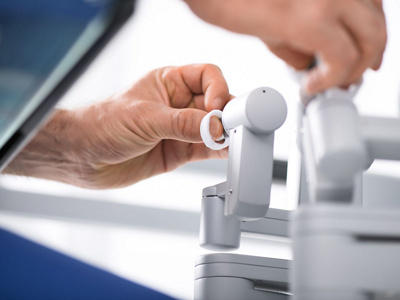The da Vinci operating system is a robot-assisted surgical system that can be used to perform minimally invasive surgical procedures.
Originally developed for heart surgery, the surgical system has now become established and widely used in the field of urology. It enables doctors to operate gently in areas of the body that require an extremely precise approach.
The da Vinci system is comprised of three elements: the actual robot with moving arms, which carry a camera and instruments, a central computer unit and an operating console. The surgeon sits at the control console and views the operating field with up to ten-times magnification via a three-dimensional video. This enables him or her to precisely identify even fine structures such as nerves and blood vessels. With millimetre precision, the surgical robot transmits the doctor’s hand movements to instruments that have been positioned inside a small incision in the patient’s abdomen. In contrast to laparoscopic instruments, which are restricted in terms of their freedom of movement, the da Vinci instruments have joints, allowing them to be turned in all directions, just like a human hand. Involuntary movements such as trembling hands are compensated for with filters.
The da Vinci robot does not work independently. The surgical system is always operated by experienced surgeons. The robot-assisted urological procedures are carried out at Klinik Im Park by Dr. med. Stephan Bauer, Dr. med. Martin Baumgartner, Dr. med. Remo André Largo, Dr. med. Daniel Seiler and Prof. Dr. med. Tullio Sulser.
Benefits of the da Vinci technology
The use of the da Vinci technology results in fewer complications. Fewer scars are created, blood loss during the procedures and postoperative pain are significantly reduced, and the risk of infection is also lower. The healing process and the duration of the hospital stay are shortened.
Complete removal of the prostate gland (radical prostatectomy) due to prostate cancer is the most common surgery worldwide in which the robot-assisted da Vinci system is used. The da Vinci technology enables doctors to clearly view, visualise and preserve nerves and the sphincter area of the bladder. This has a positive effect on maintaining continence and virility, which massively increases the quality of life of the patients who receive this treatment.
Areas of application of the da Vinci technology
The da Vinci surgical technology is suitable for almost all urological procedures:
- Complete removal of the prostate gland in patients with cancer
- Removal of kidney tumours without removing the entire organ
- Complete removal of kidneys affected by tumours or failed kidneys
- Plastic surgery to correct a constricted renal pelvis
- Removal of lymph nodes and complete removal of the bladder in patients with bladder cancer
- Lifting of the vagina (colposuspension) in patients with urinary incontinence (bladder weakness)
- Correction of uterine prolapse (sacrocolpopexy)
- Surgical treatment of benign severe enlargement of the prostate (prostate adenoma enucleation)










